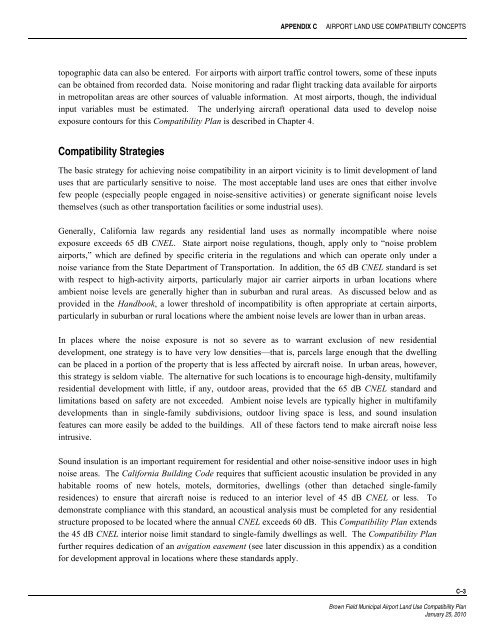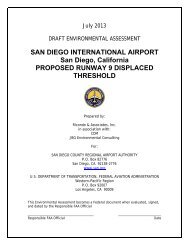Brown Field Municipal Airport Land Use Compatibility Plan
Brown Field Municipal Airport Land Use Compatibility Plan
Brown Field Municipal Airport Land Use Compatibility Plan
- No tags were found...
You also want an ePaper? Increase the reach of your titles
YUMPU automatically turns print PDFs into web optimized ePapers that Google loves.
APPENDIX CAIRPORT LAND USE COMPATIBILITY CONCEPTStopographic data can also be entered. For airports with airport traffic control towers, some of these inputscan be obtained from recorded data. Noise monitoring and radar flight tracking data available for airportsin metropolitan areas are other sources of valuable information. At most airports, though, the individualinput variables must be estimated. The underlying aircraft operational data used to develop noiseexposure contours for this <strong>Compatibility</strong> <strong>Plan</strong> is described in Chapter 4.<strong>Compatibility</strong> StrategiesThe basic strategy for achieving noise compatibility in an airport vicinity is to limit development of landuses that are particularly sensitive to noise. The most acceptable land uses are ones that either involvefew people (especially people engaged in noise-sensitive activities) or generate significant noise levelsthemselves (such as other transportation facilities or some industrial uses).Generally, California law regards any residential land uses as normally incompatible where noiseexposure exceeds 65 dB CNEL. State airport noise regulations, though, apply only to “noise problemairports,” which are defined by specific criteria in the regulations and which can operate only under anoise variance from the State Department of Transportation. In addition, the 65 dB CNEL standard is setwith respect to high-activity airports, particularly major air carrier airports in urban locations whereambient noise levels are generally higher than in suburban and rural areas. As discussed below and asprovided in the Handbook, a lower threshold of incompatibility is often appropriate at certain airports,particularly in suburban or rural locations where the ambient noise levels are lower than in urban areas.In places where the noise exposure is not so severe as to warrant exclusion of new residentialdevelopment, one strategy is to have very low densities—that is, parcels large enough that the dwellingcan be placed in a portion of the property that is less affected by aircraft noise. In urban areas, however,this strategy is seldom viable. The alternative for such locations is to encourage high-density, multifamilyresidential development with little, if any, outdoor areas, provided that the 65 dB CNEL standard andlimitations based on safety are not exceeded. Ambient noise levels are typically higher in multifamilydevelopments than in single-family subdivisions, outdoor living space is less, and sound insulationfeatures can more easily be added to the buildings. All of these factors tend to make aircraft noise lessintrusive.Sound insulation is an important requirement for residential and other noise-sensitive indoor uses in highnoise areas. The California Building Code requires that sufficient acoustic insulation be provided in anyhabitable rooms of new hotels, motels, dormitories, dwellings (other than detached single-familyresidences) to ensure that aircraft noise is reduced to an interior level of 45 dB CNEL or less. Todemonstrate compliance with this standard, an acoustical analysis must be completed for any residentialstructure proposed to be located where the annual CNEL exceeds 60 dB. This <strong>Compatibility</strong> <strong>Plan</strong> extendsthe 45 dB CNEL interior noise limit standard to single-family dwellings as well. The <strong>Compatibility</strong> <strong>Plan</strong>further requires dedication of an avigation easement (see later discussion in this appendix) as a conditionfor development approval in locations where these standards apply.C–3<strong>Brown</strong> <strong>Field</strong> <strong>Municipal</strong> <strong>Airport</strong> <strong>Land</strong> <strong>Use</strong> <strong>Compatibility</strong> <strong>Plan</strong>January 25, 2010
















